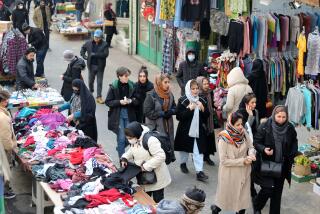Carpet makers hope to ride out sanctions
- Share via
TEHRAN — Standing next to piles of exquisitely hand-woven Persian rugs, Hossein Ghaseminia is confident his rugs, which cost as much as $50,000, can fend off cheaper Asian rivals and withstand threatened U.S. sanctions.
One of Iran’s best-known exports, Persian carpets made from silk, wool and cotton are traditionally woven by women in villages who use natural dyes derived from plants to color them in rich hues where red, brown and cream dominate.
“If we produce high-quality carpets people will continue to buy them,” said Ghaseminia, who has been in the business for more than four decades.
Selling outside Iran mainly in the United States and Germany, the Persian carpet is one of Iran’s main exports, besides oil, and is deeply ingrained in the country’s national identity. Rugs adorn the floors of most homes, and with prices for finer examples reaching many thousands of dollars, they are, for some people, an investment.
But a half-empty hall at the annual Persian Carpet Grand Exhibition last month showed the business facing tough challenges, both at home and abroad.
Drinking tea and talking shop surrounded by thousands of carpets from different parts of Iran, dealers in various types of rugs accused low-cost producers from India, Pakistan and China of copying elaborate Iranian designs.
While Iran remains ahead at the most-expensive end of the market, its overall position in the $10-billion global industry, which also includes machine-made carpets, has slipped five places to No. 8 since 2001, with Belgium on top.
Trader Ata Erad said sales were better last year but insisted there was no crisis.
“The carpet is part of life, as necessary as air and water,” Erad said, displaying both old and new wares.
“Carpets are like gold in Iran,” he added, proudly showing a 50-year-old, 24-square-meter specimen from the northwest that he said had trebled in value to nearly $70,000 in the last year.
But other dealers said raw material and wage costs had risen sharply, forcing them to hike prices. That has deterred some buyers.
“Business is not good,” Ali Mohammad Zadeh said in the stand of his family firm, laden with rugs sporting conventional motifs, such as flowers, vines, animals and geometric patterns.
Unlike in previous years, wealthy buyers from Iran’s Arab neighbors and elsewhere had not shown up, he said: “We have not even made enough money to pay for the rent. It would have been better to stay in the bazaar.”
Potentially making matters worse is a threat of renewed U.S. sanctions, which would directly affect a big market.
As part of U.S. efforts to pressure the Islamic Republic to halt its sensitive nuclear work, proposed new legislation would reimpose a total ban on Iranian imports.
The bill, sponsored by Rep. Tom Lantos (D-Burlingame), would reverse a “goodwill gesture” by President Clinton in 2000 that allowed in rugs and certain other goods from Iran.
The draft, which won overwhelming approval from a congressional committee in June, would also force President Bush to impose sanctions on energy firms dealing with Iran. The measure still needs the approval of Congress.
Iran’s carpet exports amounted to $635 million in 2005, according to the latest figures from the state-owned Iran Carpet Co. Most are top-notch hand-woven products.
Jalal Eddin Bassam, Iran Carpet’s managing director, insisted that U.S. buyers would circumvent any import ban.
He said past experience indicated that such punitive measures would not have a major negative effect on an industry that boasts a tradition dating back 2,500 years and, directly or indirectly, employs 1.4 million people in Iran.
More to Read
Inside the business of entertainment
The Wide Shot brings you news, analysis and insights on everything from streaming wars to production — and what it all means for the future.
You may occasionally receive promotional content from the Los Angeles Times.










